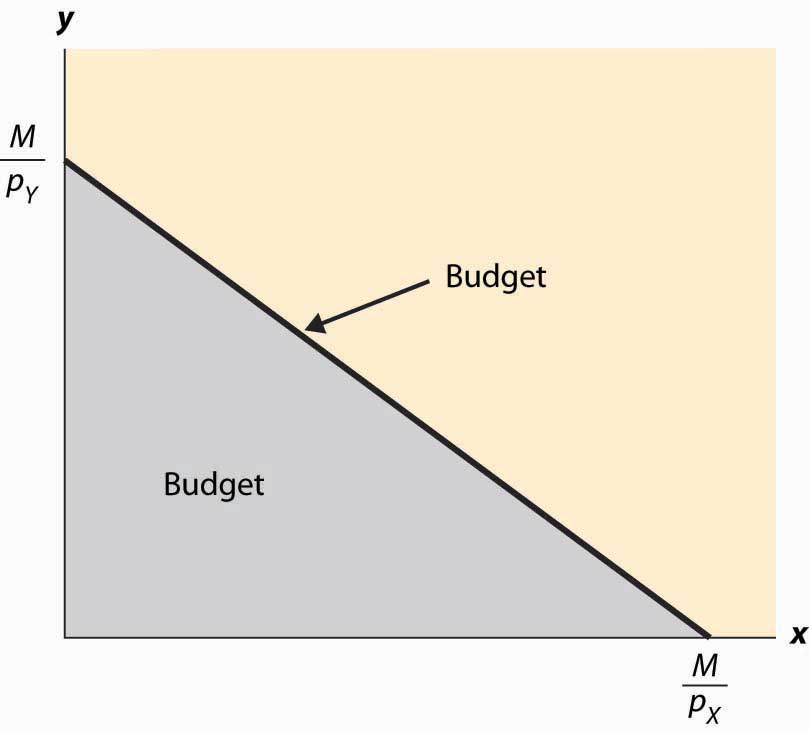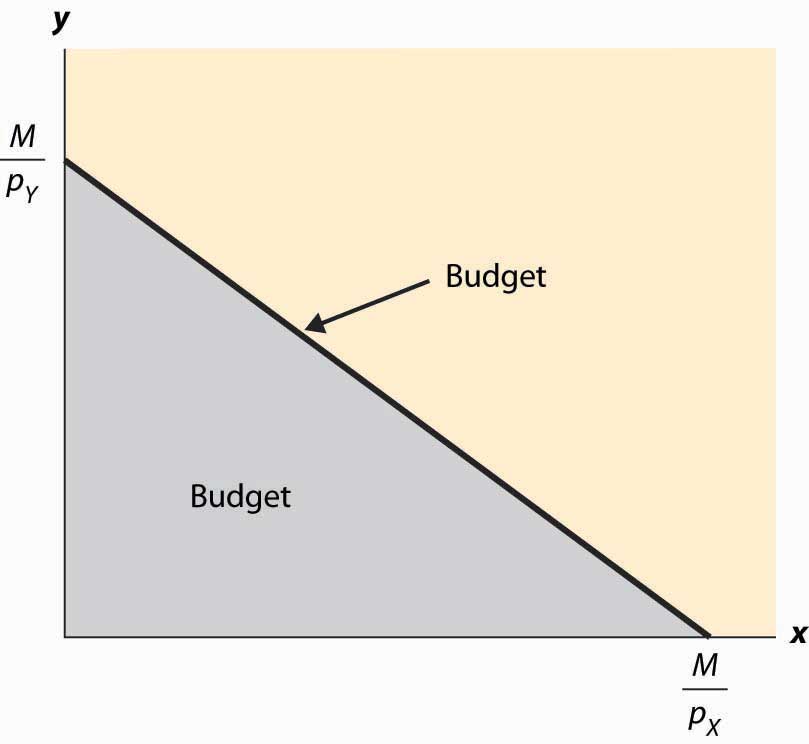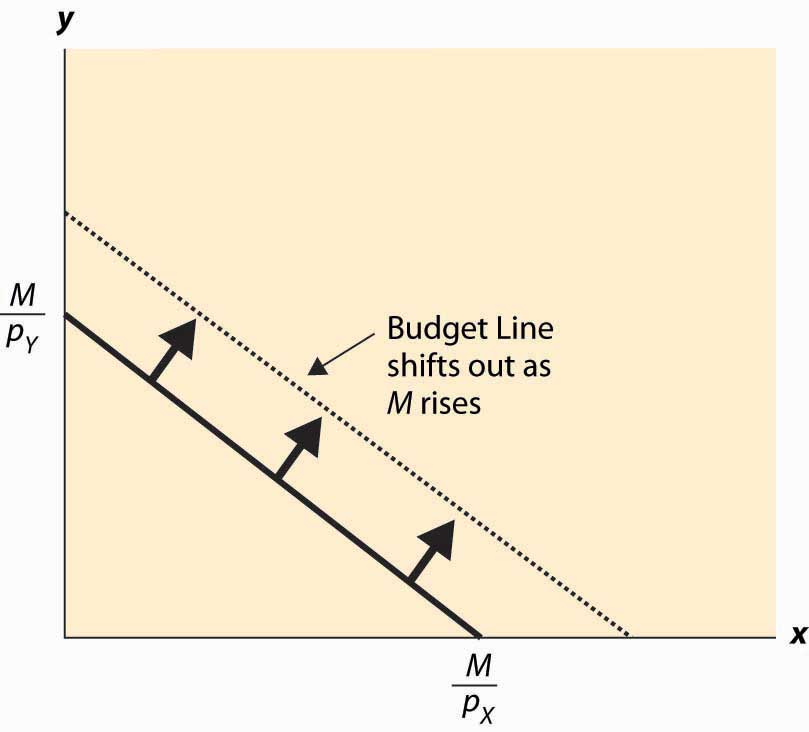How To Draw A Budget Constraint
12.2 Budget or Feasible Set
Learning Objective
- How does income limit choice?
Suppose that a consumer has a fixed amount of money to spend, M. There are two appurtenances Ten and Y, with associated prices pX and pY . The feasible choices that the consumer can brand satisfy In add-on, we will focus on consumption and rule out negative consumption, so ten ≥ 0 and y ≥ 0. This gives a budget setSet of goods a consumer can afford. or viable set, as illustrated in Figure 12.1 "Budget set". The budget set is the ready of goods a consumer can afford to buy.
The upkeep lineSet of appurtenances that but frazzle the consumer'south upkeep. is the purlieus of the budget set, and it consists of the goods that but exhaust the consumer'southward budget
Figure 12.1 Budget set

In Figure 12.1 "Budget ready", the feasible set of purchases that satisfies the upkeep constraint is illustrated with shading. If the consumer spends all of her coin on X, she tin can swallow the quantity 10 = Similarly, if she spends all of her money on Y, she consumes units of Y. The directly line between them, known every bit the budget line, represents the most of the appurtenances that she tin eat. The slope of the budget line is
An increment in the price of one good pivots or rotates the upkeep line. Thus, if the cost of X increases, the endpoint remains the same, just falls. This is illustrated in Figure 12.2 "Event of an increase in price on the budget".
Figure 12.2 Effect of an increase in price on the upkeep

The effect of increasing the bachelor money M is to increment both and proportionately. This means that an increase in M shifts the budget line out (abroad from the origin) in a parallel mode, as shown in Effigy 12.iii "An increase in income".
Figure 12.three An increase in income

An increase in both prices by the same proportional factor has an effect identical to a decrease in income. Thus, one of the three financial values—the two prices and income—is redundant. That is, we tin can trace out all of the possible budget lines with whatever two of the three parameters. This tin evidence useful. We can arbitrarily set up pX to be the number one without affecting the generality of the analysis. When setting a price to one, that related good is called the numeraireA good used every bit a reference adept, then that prices are denominated in units of that good. , and essentially all prices are denominated with respect to that one expert.
A existent-world example of a numeraire occurred when the currency used was based on gilded, so that the prices of other appurtenances were denominated in terms of the value of gold.
Money is non necessarily the only constraint on the consumption of appurtenances that a consumer faces. Time tin be equally of import. I tin own all of the meaty disks in the world, but they are useless if one doesn't actually have time to heed to them. Indeed, when we consider the supply of labor, time will exist a major issue—supplying labor (working) uses up time that could be used to consume goods. In this case, there volition be two kinds of budget constraints—a financial one and a temporal one. At a fixed wage, time and money interpret directly into i another, and the existence of the time constraint won't present significant challenges to the theory. The conventional way to handle the time constraint is to utilise, as a baseline, working "full out," and then to view leisure as a good that is purchased at a price equal to the wage. Thus, if you earn $xx an hour, we would set your budget at $480 a day, reflecting 24 hours of piece of work; but we would then permit you to buy leisure fourth dimension, during which eating, sleeping, brushing your teeth, and every other nonwork activity could be accomplished at a price equal to $xx per hour.
Primal Takeaways
- The upkeep set or feasible set is the prepare of appurtenances that the consumer can afford to purchase.
- The budget line is the pair of goods that exactly spend the budget. The budget line shifts out when income rises and pivots when the price of one good changes.
- Increasing prices and income by the same multiplicative factor leaves the feasible set unchanged.
Exercises
- Graph the budget line for apples and oranges with prices of $two and $3, respectively, and $60 to spend. At present increase the price of apples from $ii to $4, and draw the upkeep line.
- Suppose that apples cost $1 each. Water can be purchased for 50 cents per gallon upward to 20,000 gallons, and 10 cents per gallon for each gallon beyond 20,000 gallons. Draw the upkeep constraint for a consumer who spends $200 on apples and water.
- Graph the budget line for apples and oranges with prices of $2 and $3, respectively, and $60 to spend. Now increase the expenditure to $90, and draw the budget line.
Source: https://saylordotorg.github.io/text_introduction-to-economic-analysis/s13-02-budget-or-feasible-set.html
Posted by: gomeztuaid1993.blogspot.com


0 Response to "How To Draw A Budget Constraint"
Post a Comment